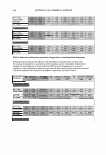400 JOURNAL OF COSMETIC SCIENCE FORMULATION BASICS Ken Klein Cosmetech Laboratories, Inc., Fai,field, NJ Emulsions are by far the most complicated and difficult of all of the vehicles we cosmetic chemists prepare. We must be concerned with a myriad ofissues: Application qualities Cost of goods Delivery of "actives" when applicable Preservation Stability (of the emulsion and of the package with the emulsion) Efficacy This short talk will discuss formulation strategies and how to address each of the above issues. We will also cover how to intelligently choose raw materials and manufacturing issues. Lastly, we will review commercial products to ascertain their strategies (sometimes good ones and sometimes not so good ones).
2004 ANNUAL SCIENTIFIC SEMINAR EMULSIFIER SELECTION AND USE Mark Chandler Uniqema, New Castle, DE 401 The essence of making a stable emulsion is creating droplets and stabilizing them. Mechanical energy (mixing), thermal energy (heat), and chemical energy ( emulsifiers and stabilizers) are employed in various amounts to accomplish this humble task. The job of the creative cosmetic chemist is to use these tools to create the next great cream or lotion. The good cosmetic chemist has to think not only of stability of the product, but the aesthetics and performance of the product as well. Can the approach to stabilizing the emulsion help with these aspects as well? The cosmetic chemist generally thinks of emollients and actives/functional materials first when asked to design the next great cream or lotion. It is suggested that this habit be broken. With Marketing calling the shots, the selection of actives or functional materials will never leave its place of prominence, but the prominence of emulsion and emulsifier selection should rise higher than its current status. Armed with information on the particular active or functional material to be used and an idea of the needs and desires of the target market (Marketing WILL tell us that, right?), the cosmetic chemist can select the emulsion 'platform' that is right for the job. There are four primary stabilization mechanisms to choose from: 1) lOillC 2) steric 3) polymeric 4) liquid crystalline Ionic stabilization is the oldest method used. Soap-based emulsions have been produced for centuries and are still in use today. More modern anionic and cationic emulsifiers are finding their way into formulations. These emulsifiers build an ionic double-layer around emulsion droplets leading to electrical repulsion of the droplets. These emulsifiers tend to be efficient but have limitations in terms of pH, salt tolerance, and irritation potential. The mechanism that is most flexible and most widely used for making oil-in-water emulsions, steric stabilization, requires the most finesse in order to produce a stable, easily manufactured product. Such timesaving tools as the Hydrophile-Lipophile Balance System (filB), the Lin method of oil phase water solubilization determination, and Phase Inversion Temperature (PIT) have proven to be very useful in the formulation process, especially if steric stabilization is to be used as the primary stabilization mechanism. In many cases ionic and steric stabilization are used together. The use of polymeric materials as primary emulsion stabilizers has increased in the past few years. These stabilize by building 'zero shear viscosity' in the aqueous phase of an emulsion and have some interaction at the surface of emulsion droplets. Though
Purchased for the exclusive use of nofirst nolast (unknown) From: SCC Media Library & Resource Center (library.scconline.org)






































































































